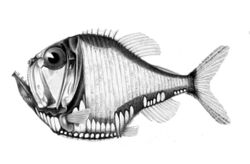Biology:Argyropelecus olfersii
| Argyropelecus olfersii | |
|---|---|

| |
| Scientific classification | |
| Domain: | Eukaryota |
| Kingdom: | Animalia |
| Phylum: | Chordata |
| Class: | Actinopterygii |
| Order: | Stomiiformes |
| Family: | Sternoptychidae |
| Genus: | Argyropelecus |
| Species: | A. olfersii
|
| Binomial name | |
| Argyropelecus olfersii (Cuvier, 1829)
| |
Argyropelecus olfersii is a common species of marine hatchetfish,[1] found in mesopelagic waters.
Discovery and naming
Argyropelecus olfersii was described by Georges Cuvier in Chapter 27 of Histoire Naturelle des Poissons, based on specimens held in the National Museum of Natural History in Paris and the Natural History Museum, Berlin. The specific name honours the German diplomat and natural historian Ignaz von Olfers, who presented the Berlin specimen to the museum upon his return from a diplomatic excursion to Brazil.[2]
Distribution and habitat
A. olfersii is found in temperate waters worldwide, with a preferred temperature range of 5.1-13.3°C.[3] The fish is present in all oceans save the Southern, however records are rare from the Indian Ocean.[1] During daylight hours, subadult and adult fish live at depths of 200-800m, undergoing a vertical migration to 100-600m at sunset.[3]
Description

Like other members of the subfamily Sternoptychinae, Argyropelecus olfersii has a laterally compressed and extremely deep body, contributing to the characteristic "hatchet" shape which the group is named after. This shape, alongside the counterillumination provided by the well-developed ventral photophores, reduces the silhouette of the fish when viewed from beneath, concealing it from potential predators. In addition to the ventral photophores, an eye-facing photophore is found in the snout, used as part of a feedback system to allow the ventral bioluminescence to match the intensity of downwelling light.[4] A. olfersii has a dark, heavily pigmented back and silvered flanks, again helping to reduce visibility in its native midwater habitat. Like all members of the genus Argyropelecus, A. olfersii has dorsally-directed, tubular eyes, which in life have a metallic blue colouration that is rapidly lost in preserved specimens.[2]
A. olfersii is distinguished from other members of the genus by its two postabdominal spines, which are equal in length and curvature. There are 9 rays in the dorsal fin, 10–11 in the pectorals, 6 in the pelvic fin and 12 rays in the anal fin.[5] In addition to these fins, there is a long, low adipose fin on the ventral surface of the tail and a dorsal blade anterior to the dorsal fin. The otoliths in this species are small, and located under the cranium behind the eyes.
Ecology
Argyropelecus olfersii is a predator, feeding on small fish and crustaceans.[3] Despite being an abundant member of the mesopelagic community, A. olfersii is a relatively poor source of energy, and there is evidence suggesting that it is actively avoided by some marine mammal predators in favour of more energy-rich myctophids.[6]
Relationship to humans
Argyropelecus olfersii is not fished commercially, and has an assessment of Least Concern under the IUCN Redlist.[7] Organohalogen pollutants have been found in A. olfersii specimens caught in the Bay of Biscay.[8]
References
- ↑ 1.0 1.1 "Argyropelecus olfersii (Cuvier, 1829)" (in en). https://www.gbif.org/species/2347591.
- ↑ 2.0 2.1 Cuvier, Georges; Valenciennes (1828). Histoire naturelle des poissons. Paris: Chez F. G. Levrault. doi:10.5962/bhl.title.7339. https://www.biodiversitylibrary.org/bibliography/7339.
- ↑ 3.0 3.1 3.2 Froese, R; Pauly, D (2023). "Fishbase". https://fishbase.se/summary/Argyropelecus-olfersii.html.
- ↑ Davis, Alexander L.; Sutton, Tracey T.; Kier, William M.; Johnsen, Sönke (2020-06-10). "Evidence that eye-facing photophores serve as a reference for counterillumination in an order of deep-sea fishes" (in en). Proceedings of the Royal Society B: Biological Sciences 287 (1928): 20192918. doi:10.1098/rspb.2019.2918. ISSN 0962-8452. PMID 32517614. PMC 7341941. https://royalsocietypublishing.org/doi/10.1098/rspb.2019.2918.
- ↑ Whitehead, P. J. P.; Bauchot, M.-L.; Hureau, J.-C.; Nielsen, J.; Tortonese, E. (1986). Fishes of the North-Eastern Atlantic and Mediterranean. UNESCO. ISBN 92-3-002308-6.
- ↑ Spitz, Jérôme; Mourocq, Emeline; Leauté, Jean-Pierre; Quéro, Jean-Claude; Ridoux, Vincent (2010-07-31). "Prey selection by the common dolphin: Fulfilling high energy requirements with high quality food" (in en). Journal of Experimental Marine Biology and Ecology 390 (2): 73–77. doi:10.1016/j.jembe.2010.05.010. ISSN 0022-0981. https://archimer.ifremer.fr/doc/00011/12221/9086.pdf.
- ↑ Harold, A; Milligan, R (2019). "Argyropelecus olfersii. The IUCN Red List of Threatened Species". https://www.iucnredlist.org/species/18253287/21913744.
- ↑ Munschy, C.; Spitz, J.; Bely, N.; Héas-Moisan, K.; Olivier, N.; Pollono, C.; Chouvelon, T. (2022-11-01). "A large diversity of organohalogen contaminants reach the meso- and bathypelagic organisms in the Bay of Biscay (northeast Atlantic)" (in en). Marine Pollution Bulletin 184: 114180. doi:10.1016/j.marpolbul.2022.114180. ISSN 0025-326X. https://archimer.ifremer.fr/doc/00795/90738/99562.pdf.
Wikidata ☰ Q1144363 entry
 |



